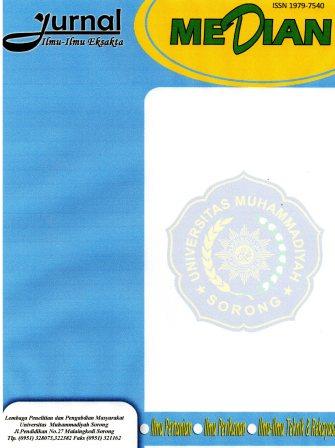Biomasa Karbon Below Ground Paraserianthes Falcataria (L.) Nielsen pada Lahan Agroforestri Tradisional di Distrik Aimas, Sorong
DOI:
https://doi.org/10.33506/md.v16i3.4176Keywords:
Bellow Ground, Karbon Biomassa, Paraserianthes Falcataria (L,) Nielsen, Agroforestri TradisionalAbstract
Forests as part of the environment have a big role in maintaining ecosystem stability. One of them is as a carbon store. Vegetation in forests can prevent the release of carbon into the atmosphere through the process of photosynthesis where vegetation absorbs CO2 then breaks it down and stores it in the form of biomass. This is what makes it important for forest friends to study their ability to store biomass and carbon specifically on Agroforestry land as one of the site level forest management units. The aim of this research is to develop an allometric equation model to estimate the value of carbon biomass stored in bellow ground specifically for stands on traditional agroforestry land. The method used is a destructive sampling by selecting sample trees purposively and selecting three samples. trees with different diameters at breast height (dbh) but the same age representing stands on agroforestry land in Aimas District, Sorong Regency. biomass and carbon measurements were carried out through laboratory tests. The total below ground biomass content of the 19 of Paraserianthes falcataria stands obtained was 0.369 tons/ha. The below ground carbon content of sengon stands on 2.8 hectares of agroforestry land is 0.184 tonnes C/ha.
References
Atmosuseno, BS. 1998. Budi Daya, Kegunaan dan Prospek Sengon. Jakarta : Penebar Swadaya.
Brown, S. 1997. Estimates Biomass And Biomass Change of Tropical Forest,USA : FAO Forestry Paper no. 134.
Budiadi dan Sabarnurdin, M.S. 2001. Struktur Biomassa di Atas dan Bawah Permukaan Tanah Tanaman Jati dengan Modifikasi Pola Tanam. Buletin Kehutanan No. 47. Universitas Gadjah Mada. Yogyakarta.
Elias, N.J.Wistara, M. Dewi dan H. Purwitasari. 2010. Model Persamaan Massa Karbon Akar Pohon dan Root-Shoot Ratio Massa Karbon. Jurnal Manajemen Hutan Tropika 16 (3):113-117.
Hairiah, K dan Rahayu, S. 2007. Pengukuran Karbon Tersimpan di Berbagai Macam Penggunaan Lahan. World Agroforestry Centre. ICRAF Southeast Asia Regional Office. Bogor
Hairiah, K, dkk. 1999. Petunjuk Praktis : ‘’Karbon Tersimpan’’ di Berbagai Macam Penggunaan Lahan. Bogor. World Agroforestry Center, ICRAF, SEA Regional Office, University of Brawijaya (Unibraw), Indonesia. 77 p.
IPCC, 2003. Good Practice Guidance for land use, land-use change and forestry. Intergovernmental Panel on Climate Change Nationnal Greenhouse Gas Inventories Programme. www.ipcc-nggip.iges.or.jp/lulucf/gpglulucf_unedit.html
Kaliky. F, Ohorella. S, 2011. Biomassa dan Karbon dibawah Permukaan Tanah Tegakan Sengon (Paraserianthes falcataria L. Nielsen) pada Lahan Agroforestry. Jurnal Agrohut. Vol 2 no 2 hal 110.
Khalif, U. dkk. 2014. Pengaruh Penanaman Sengon terhadap kandungan C dan N Tanah di Desa Salamparejo, Jabung. Malang. Jurnal Tanah dan Sumberdaya Lahan Vol 1 No. 1 Hal 09-15
Mutua J, dkk. 2014. Conservation agriculture with trees: principles and practice. World AgroforestryCentre (ICRAF
Murdiyarso D. 2003. Protocol Kyoto, Implikasinya Bagi Negara Berkembang. Jakarta: Penerbit Kompas.
Ohorella, S., Febriadi, I., & Sangadji, Z. (2022). Sengon Biomass Carbon Stock in Tradisonal Agroforestry land Tipe; Climate Change. Agrikan Jurnal Agribisnis Perikanan, 15(2), 759-769.
Senjaya, N. dkk 2018. Evaluasi Sistem Agroforestri Sengon dengan Padi Gogo terhadap Serangan Cendawan Rhizoctonia sp. Jurnal Silvikultur Tropika. Vol 09, No 02, Hal 120-126.
Solichin. 2010. Pengukuran Emisi Karbon di Kawasan Hutan Rawa Gambut Merang. Makalah pada Lokakarya Proses penentuan Tingkat Emisi Acuan pada berbagai lokasi ujicoba REDD di Indonesia dan kaitannya dengan REL nasional Bogor, 30 Juni 2010.
Uddin, MB, Mukul, SA, Khan, MA, Hossain, MA. 2009. Seedling response of three agroforestry tree species to phosphorous fertilizer application in Bangladesh: growth and nodulation capabilities. Journal of Forestry Research 20(1):45−48
Downloads
Published
How to Cite
Issue
Section
License

This work is licensed under a Creative Commons Attribution-ShareAlike 4.0 International License.
Authors who publish with this journal agree to the following terms:
Authors retain copyright and grant the journal right of first publication with the work simultaneously licensed under a Creative Commons Attribution-ShareAlike (CC BY-SA)Â that allows others to share the work with an acknowledgement of the work's authorship and initial publication in this journal.
Authors are able to enter into separate, additional contractual arrangements for the non-exclusive distribution of the journal's published version of the work (e.g., post it to an institutional repository or publish it in a book), with an acknowledgement of its initial publication in this journal.
Authors are permitted and encouraged to post their work online (e.g., in institutional repositories or on their website) prior to and during the submission process, as it can lead to productive exchanges, as well as earlier and greater citation of published work.





